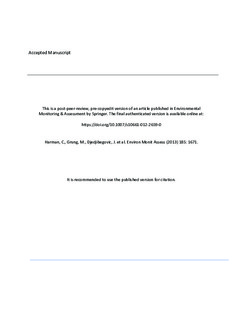Screening for Stockholm Convention persistent organic pollutants in the Bosna River (Bosnia and Herzogovina)
Harman, Christopher Peter; Grung, Merete; Djedjibegovic, Jasmina; Marjanovic, Aleksandra; Sober, Miroslav; Sinanovic, Kemo; Fjeld, Eirik; Rognerud, Sigurd; Ranneklev, Sissel Brit; Larssen, Thorjørn
Journal article, Peer reviewed
Accepted version
Permanent lenke
http://hdl.handle.net/11250/2579082Utgivelsesdato
2013Metadata
Vis full innførselSamlinger
- Publikasjoner fra Cristin - NIVA [2160]
- Scientific publications [1172]
Originalversjon
Environmental Monitoring & Assessment. 2013, 185 (2), 1671-1683. 10.1007/s10661-012-2659-0Sammendrag
The Stockholm Convention, which aspires to manage persistent organic pollutants (POPs) at the international level, was recently ratified in Bosnia and Herzegovina (BiH). Despite this fact, there is in general a paucity of data regarding the levels of POPs in the environment in BiH. In the present study, screening for POPs was conducted in one of the country’s major rivers, the Bosna. A two-pronged approach was applied using passive samplers to detect the freely dissolved and bioavailable concentrations in the water phase and sediment analysis to provide an integrated measure of historical contamination. At several places along the river, the concentrations of polycyclic aromatic hydrocarbons (PAH) were high and exhibited potential for both chronic and acute effects to biota. River water also showed elevated concentrations of PAH, up to 480 ng L−1 near the city of Doboj, and diagnostic ratios suggested combustion sources for the contamination present in both types of sample. The levels of the other contaminants measured—polychlorinated biphenyls (PCBs), organochlorine pesticides (OCPs) and polybrominated diphenyl ethers—were generally low in the water phase. However, PCBs and some OCPs were present in river sediments at levels which breach the international criteria and thus suggest potential for ecological damage. Additionally, the levels of heptachlor breached these criteria in many of the sites investigated. This study presents the first screening data for some of these Stockholm Convention relevant compounds in BiH and reveals both low concentrations of some chemical groups, but significant point sources and historic contamination for others.
